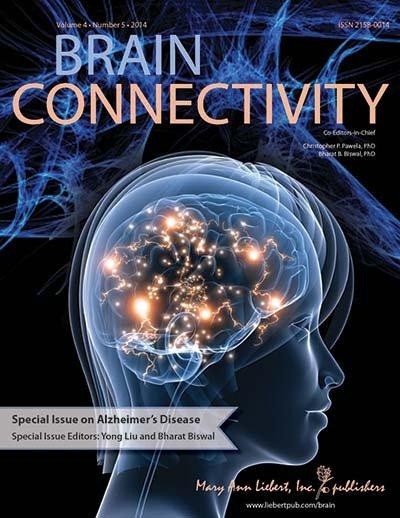For Immediate Release
Can Amyloid Plaque in Alzheimer's Disease Affect Remote Regions of the Brain?
Contact: Kathryn Ryan
914-740-2250
kryan@liebertpub.com

New Rochelle, NY, July 21, 2014—In Alzheimer's disease, accumulation of amyloid plaque in the brain is believed to play an important role in many characteristic disease symptoms, including memory loss and other mental state changes. But how these plaque deposits affect brain function is not well understood. Important new study results showing that plaque buildup in one area of the brain can negatively affect metabolism in a more distant brain region have been published in Brain Connectivity, a peer-reviewed journal from Mary Ann Liebert, Inc., publishers. The article is available free on the Brain Connectivity website until August 21, 2014.
As part of a special issue focused on Alzheimer's disease, Elisabeth Klupp and coauthors, Technische Universtät München (Munich and Garching, Germany) and University Hospital of Cologne, Germany, present the results of an imaging-based study demonstrating that amyloid buildup in one brain region can impair brain cell metabolism and activity another in remote brain region not affected by amyloid plaque accumulation. The regions studied were part of the same functional network but are located remotely from each other in the brain. The authors suggest this long-distance effect may be the result of diminished neuronal signals originating from the amyloid-affected brain region to the remote amyloid-unaffected brain region. The findings are discussed in the article “In Alzheimer's Disease, Hypometabolism in Low-Amyloid Brain Regions May Be a Functional Consequence of Pathologies in Connected Brain Regions.”
“This research may be an important new discovery that links two important hypotheses in Alzheimer’s disease research: the amyloid buildup hypothesis and the network degenerating hypothesis,” says Christopher Pawela, PhD, Co-Editor-in-Chief and Assistant Professor, Medical College of Wisconsin.
About the Journal
Brain Connectivity is the essential peer-reviewed journal covering groundbreaking findings in the rapidly advancing field of connectivity research at the systems and network levels. Published 10 times per year in print and online, the Journal is under the leadership of Founding and Co-Editors-in-Chief Christopher Pawela, PhD, Assistant Professor, Medical College of Wisconsin, and Bharat Biswal, PhD, Chair of Biomedical Engineering, New Jersey Institute of Technology. It includes original peer-reviewed papers, review articles, point-counterpoint discussions on controversies in the field, and a product/technology review section. To ensure that scientific findings are rapidly disseminated, articles are published Instant Online within 72 hours of acceptance, with fully typeset, fast-track publication within 4 weeks. Tables of content and a sample issue may be viewed on the Brain Connectivity website.
About the Publisher
Mary Ann Liebert, Inc., publishers is a privately held, fully integrated media company known for establishing authoritative medical and biomedical peer-reviewed journals, including Journal of Neurotrauma and Therapeutic Hypothermia and Temperature Management. Its biotechnology trade magazine, Genetic Engineering & Biotechnology News (GEN), was the first in its field and is today the industry’s most widely read publication worldwide. A complete list of the firm’s 80 journals, newsmagazines, and books is available on the Mary Ann Liebert, Inc., publishers website.